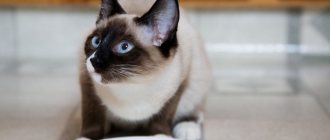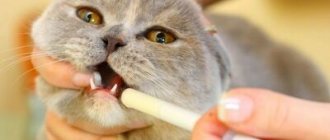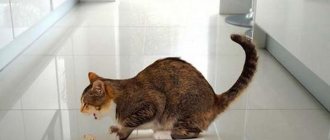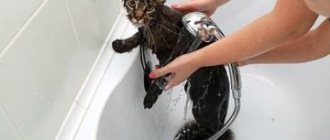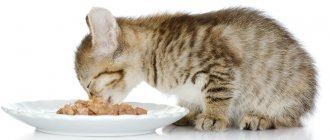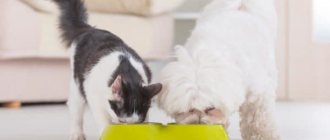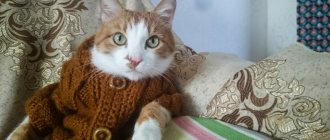Thanks to sterilization, you can not only avoid the appearance of unwanted offspring, but also prevent the development of cancer. The benefits of this operation outweigh the risks, which is why veterinarians strongly recommend it, even before the onset of the first heat.
It is important not to forget that such an intervention in the body requires a mandatory adjustment of the diet. Knowing what you can feed a sterilized cat at home, you can avoid its obesity and other common problems associated with hormonal changes.
Features of feeding a cat after sterilization
Sterilization causes your pet's metabolism and urination frequency to slow down, which can cause urolithiasis or obesity.
Sterilization is a stressful procedure for a cat, after which its hormonal levels and behavior change
It must be fed according to certain rules:
- In the first days, do not give your pet solid food. While the stitches were healing, the stool had to be liquid so that they would not come apart during a visit to the toilet.
- Warm food to room temperature.
- Provide the animal with constant access to water.
Treatment and protection of the seam after sterilization of the cat
After sterilization, a postoperative suture remains on the cat’s body. It may be on the stomach or on the side if the operation was performed using laparoscopy, which involves punctures. Throughout the entire rehabilitation period, it is important that the suture remains dry and clean.
To protect the postoperative wound from infection and prevent the animal from accessing the unhealed suture after the surgical procedure, a bandage or a special blanket is put on the cat - a fabric bandage with several ties for fixation on the back.
External sutures are placed with surgical thread, which will need to be removed after approximately 7-10 days. Before removing the threads, the owner needs to treat the wound using an antiseptic that does not contain alcohol (can cause skin burns). This treatment will reduce the risk of contamination of the suture and infection entering the wound.
Postoperative suture care:
1. The suture area can be treated with Chlorhexidine solution using a regular pipette to apply to the wound.
2. To speed up the healing process, the area around the suture can be lubricated with Levomekol ointment. 3. To prevent infection of the wound, it is recommended to treat the suture area once a day with a special spray - Vetericin, Aluminum or other compounds of a similar effect. It is better to process the seam after sterilization together with an assistant: one person will hold the cat, the second will carry out the processing procedure, carefully rolling up the blanket.
On days 7-10, the sutures are removed at the veterinary clinic. If before this moment the owner notices signs of suppuration, inflammation or bloody discharge in the wound area, the animal should be immediately shown to a doctor! This may indicate the development of postoperative complications, which may be associated with wound infection.
When can you remove a blanket or bandage?
The duration of wearing a blanket or bandage is determined individually, which depends on the speed of the wound healing process and the behavior of the cat. On average, this accessory is worn for 5-7 days and is removed if there are no signs of wound inflammation.
If sterilization was carried out laparoscopically, the period of wearing the bandage can be only 2-3 days. In any case, only an experienced veterinarian can determine the possibility of removing a fabric bandage from an operated animal after a diagnostic examination of the cat, assessment of the condition of the wound and its well-being.
Food and drink in the first days after surgery
The cat does not tolerate anesthesia very well. As soon as she begins to move away from him, you should give the pet something to drink through a syringe. You should not feed her immediately after surgery.
In the first days, portions should be a third of the usual dose. Choose food that is low-fat and easily digestible. The animal begins to eat independently on the third day after surgery.
Portions should be increased without exceeding the norm of 150 g per day. Due to the tendency of a sterilized cat to become obese, the daily amount of food can be reduced to 120-130 g.
The first hours after surgery
The operation lasts about half an hour, after which you can take your pet home. After surgery, you need to treat your pet with special care. The basic rule is not a drop of cold. Wrap the cat in a blanket and transport it in a well-warmed car. Under anesthesia, a cat may urinate involuntarily, so prepare a moisture-absorbing diaper and do not allow the animal to become overcooled in the slightest.
During recovery from anesthesia (2-3 hours after surgery), it is important to strictly adhere to the following rules:
- Keep the animal warm.
- Don't let your cat go up on high ground.
- Don't let the cat out of your sight.
- Force your cat to blink.
It is important to know that during anesthesia the animal does not blink, which causes the mucous membrane of the eye to begin to dry out. Therefore, we must make them “blink” forcibly. “Close” the animal’s eyes, using your fingers to help, or apply moisturizer to the eyes.
Don't let the cat disappear from sight; keep an eye on it constantly. When coming out of anesthesia, she may behave unusually, she needs help and peace. Try to lay on your right side.
Diet preparation
A properly composed diet is an opportunity to prevent urolithiasis and obesity.
In the first days, portions should be a third of the usual dose.
The cause of the disease may be an excess of:
- Vitamin A (found in cheese, liver, butter).
- Glutamic acid (found in seafood, fish, tomatoes).
- Magnesium (found in nuts, beans, chocolate).
- Phosphorus (found in eggs, fish, peas, corn).
The daily amount of feed should be 30-60 g per 1 kg of animal.
The daily norm contains:
- 35% protein. The animal's body does not produce it on its own.
- 35% carbohydrates, important for maintaining energy.
- 30% fat. Their deficiency contributes to the appearance of problems with the skin and coat, while an excess leads to excess weight gain.
Be sure to read:
Royal Canin food for sterilized cats: features, composition, wet, advantages and disadvantages
You cannot mix natural food and industrial feed.
How much and when to feed
It is better to start feeding your cat after sterilization after 12 hours. On the second day you need to give food in small portions. Then bring the nutritional intake to the one indicated on the food packaging for sterilized cats.
You need to feed your pet two to three times a day.
According to veterinarians, per day a cat needs:
- meat – 70-120 g,
- dairy products – 30-60 g,
- vegetables – 35-50 g,
- cereals – 10-20 g.
If symptoms of obesity appear, it is necessary to transfer the animal to fractional feeding. The daily intake should be divided into parts and the pet should be fed 4-5 times a day.
Attention! It is important that your cat always has clean water. In summer it should be changed 4 times a day, in winter - 1-2 times.
Changing your approach to feeding your cat
After sterilizing a pet, owners need to change their views on feeding it. First, you need to limit the amount of food you eat. It is a myth that the bowl should always be filled to the brim, and the cat itself knows how much it needs to eat. Therefore, you need to strictly observe the daily norm, giving it once a day or several feedings during the day. And don’t feel sorry for the little glutton if she “cries” next to an empty bowl. Once given a food reward, your cat will use the same techniques over and over again if he realizes they work.
Secondly, you need to monitor the physical condition of the animal. If the cat receives the recommended portion, and at the same time remains normal, then she has enough. If a standard portion causes weight gain, it must be reduced or the diet changed.
Visually it is not always possible to adequately assess the degree of fatness of an animal, so weighing is optimal. Only constant monitoring by the owners and individual adjustment of the amount of food will allow the cat to stay in shape.
How to understand that the food has been chosen correctly
It is important that the cat always has clean water.
If after surgery the cat's diet consists only of natural food, it will not receive the required amount of nutrients. Therefore, you need to use a balanced feed containing vitamins and minerals.
The fact that the food is suitable is indicated by:
- a good appetite;
- regular bowel movements, absence of constipation and indigestion;
- well-groomed, shiny coat;
- no loss of shreds;
- good health.
Possible complications after surgery
It is important to distinguish between normal and cause for concern. How do you understand that something has gone wrong and you need to urgently call a doctor? We list the main possible complications and recommendations on what should be done in each case.
a cat to recover from anesthesia. If the cat does not get up for the second day, its paws are cool, the temperature is low (below 37) - it’s time to be alarmed. Massage the paws, put him in a warm place, cover him warmly and report the problem to the veterinarian.
Bleeding. If traces of blood are detected in the area of the suture or vulva - there is a risk of intra-abdominal bleeding - the cat must be urgently taken to a veterinary hospital for repeated surgery.
Fever. If a cat has a high temperature (above 39) this is also a cause for concern. You should contact your doctor.
Swelling, redness, signs of rotting around the seam. These are all symptoms of infection and disruption of the healing process. Redness is possible in the first 3-5 days, but if the phenomenon continues to be observed on the 6th day, you should be alarmed.
Rotting can occur due to poor hygiene and irregular treatment of seams with an antibacterial agent. If this happens, further surgery may be necessary.
Growth, swelling in the suture area. If you notice the appearance of a lump in the suture area, this is also a reason to consult a doctor.
Feeding sterilized cats natural food
The basis of natural food is meat. It contains taurine, which promotes proper metabolism. If it is deficient, the animal's vision is impaired and its immunity is reduced.
It is better to give turkey or chicken, less often beef. A couple of times a week you can feed boiled poultry hearts, livers or gizzards. Store-bought meat products should be frozen for 10-14 days.
Sometimes you can pamper your pet with sea fish , but river fish should be completely excluded from the diet: it contains a lot of small bones.
The basis of natural food is meat
It wouldn’t hurt to prepare canned meat:
- Freeze chicken wings, necks, pork cartilage, and ears for four days.
- Boil the offal.
- Twist through a meat grinder.
- Add vitamin B12 to the minced meat.
- Roll up in glass jars or package in bags and freeze.
Because cats are reluctant to drink water but must consume large amounts of liquid, they must be introduced to meat broths.
Attention! Raw, unfrozen meat products and fish can cause helminthiasis, and fresh meat can lead to protein intoxication.
The diet should contain low-fat dairy products: kefir, cottage cheese, sugar-free yogurt. To ensure that your cat gets enough carbohydrates, you need to feed it cereal.
Be sure to read:
Can cats eat fish: how much can you give, what are the benefits and harms, what is not allowed, combination with food
Rice, buckwheat, wheat or barley cereals are suitable. Pearl barley porridge should be excluded, it leads to constipation. You can't give semolina.
To avoid obesity, you should choose low-calorie food for your cat after sterilization.
You need to add vegetables to your food that contain fiber , which plays an important role in digestion. Potatoes are prohibited in any form.
There are fruit lovers among cats. They can also be given in small quantities. The healthiest ones are seasonal apples.
At times, cats like to chew grass, so it is worth growing oat or wheat greens. You can purchase the grass already prepared at a pet store.
Advice! To avoid obesity, you should choose low-calorie food for your cat after sterilization.
For good health, vitamins and microelements are added to natural food..
Bone meal is used for strong bones, and sulfur is used to improve wool. Usually, after surgery, veterinarians recommend giving your pet vitamin complexes or healthy supplements.
General information
Let's start with safety precautions, which must be followed regardless of the circumstances. Whether your cat is recovering from a dental cleaning or recovering from abdominal surgery, she will experience toxicity until she fully recovers from anesthesia.
All drugs for anesthesia are, roughly speaking, drugs that lead to muscle relaxation and temporary cessation of the sensitivity of certain areas of the brain. Often, while under the influence of anesthesia, a cat hallucinates, sees pictures, hears sounds or senses something that is not there. All these oddities can prompt your pet to take unexpected actions. Unfortunately, many owners have learned from their own experience that a cat can cause serious injury to itself after anesthesia.
To avoid obvious risks, you should do the following:
- Do not leave your cat unattended until it has completely recovered from anesthesia! It is necessary! If you need to leave for a short time, your pet should be locked in a carrier. To make it more convenient while the cat is sleeping, do not take it out of the carrier, but simply remove the lid.
- Place the carrier with the cat on the floor to prevent the pet from falling. Falling from a height is dangerous because the impact causes the cat to tense up and the seams may come apart.
- Close all windows and vents - yes, some cats very quickly “drop in” from the windows of multi-story buildings if they imagine something.
- Immediately after surgery, put an Elizabethan collar or blanket on your cat (as recommended by your doctor). You may not even notice your cat has woken up, but owners have learned that cats' sharp teeth can remove stitches in seconds.
Note! Even if the cat has undergone a standard, simple operation, all sterility measures must be observed during the rehabilitation period!
After castration of the cat, make sure that he does not remove the collar and that the tray filler is clean. After sterilizing your cat, stock up on several blankets so that you can change them as needed.
On the first day after surgery, the cat will not be able to regulate its temperature, so it is important to keep it warm. Make sure that the carrier is not in a draft. If paws feel cool, use a heating pad. Woolen fabric or special thermal blankets help preserve body heat. If the cat is constantly losing temperature, it is placed on a heating pad with a temperature of 38–39.5°, covered with a light piece of wool and foil.
Important! While the cat is sleeping, it needs to be turned from one side to the other every 1.5–2 hours, this stimulates blood circulation and reduces the risk of developing edema.
Please note that the residual effect of anesthesia may last a day or more. Delayed intoxication also happens, especially if the cat has liver or kidney problems. You need to keep watch over your pet for at least a day, so you need to ask someone for help in advance. The cat will sleep, but not deeply, she will hear most of the sounds, so it is important not to fuss. Even if you are worried, speak in a confident tone and remain as calm as possible. You need to understand that the cat is in pain and scared, and your confidence will support it. If your pet tries to raise its head or stand up, immediately indicate your presence with your voice. Perhaps the cat does not want to go anywhere, and its attempts to move are associated with a feeling of loneliness and fear.
Important! If the animal has a large stitch on its body, for example, after surgery to remove a tumor, strictly follow the doctor's instructions for changing the bandages. A stale bandage can cause the wound to become infected and cause itching, which encourages the cat to make unnecessary movements.
About a day after the operation, you will be faced with a very important question - what to feed and whether it is possible to feed the patient. Please note that if the veterinarian has indicated that you cannot feed the cat, this recommendation must be strictly followed. For example, after intestinal surgery, even a small amount of food will cause damage to the suture or inflammation. Hunger weakens the body, so to maintain it, the cat is given IVs with vitamin complexes and buffer solutions.
Feeding sterilized cats with industrial food
You need to purchase premium or super-premium food.
Feeding a cat only industrial dry food increases the risk of urolithiasis.
Cheap food is of poor quality and contains large amounts of heavy minerals and salts that contribute to the development of kidney and liver diseases.
When eating such food, the pet’s body weakens and does not have time to cleanse itself in a timely manner; salts are deposited in the bladder and kidneys, forming stones. Therefore, cheap Kitekat, Whiskas, Friskies, Happy Cat should be excluded.
You need to purchase premium or super-premium food. The rate of protein absorption should be more than 80%, and the amount of salts should be minimal.
Usually this food is marked “For sterilized cats.” It contains fewer calories, fat and moderate amounts of phosphorus, calcium and magnesium. Enriched with microelements and immunostimulants.
Popular manufacturers:
- ProPlan. They produce dry food, canned food and spiders. They are made from fish, beef, and poultry.
- Royal Canin. In addition to dry food, they produce pates, jellies, and sauces. There are rulers for different genders and ages.
- Hill's. Made from chicken meat. Contains no more than 9% fat and L-carnitine.
- 1st Choice. Made from chicken meat. Does not contain corn or wheat. Contains oats, barley, brown rice.
Be sure to read:
What to feed a castrated cat: diet recommended by veterinarians
Expensive foods may not be labeled “For sterilized cats ,” but they are suitable for feeding after surgery.
your task is to choose the right diet for the animal (less fat and calories, more minerals)
Holistics contain an increased amount (from 40 to 75%) of protein. These are Now Natural, Go!, Orijen, Acana.
The quality of the feed is indicated by the following characteristics:
- ingredients are listed in descending order, meat comes first;
- the food does not contain flavoring additives or dyes;
- contains L-carnitine, which speeds up metabolism and burns fat;
- contains L-lysine, which supports muscle mass.
Canned food wins over dry food. They contain a dosed amount of moisture that does not require additional fluid intake. Canned food and dry food should be alternated, using products of the same brand.
When choosing food, you should take into account the innate characteristics of the animal. For example, the British cat and the Scottish Fold have poorly developed joints.
Therefore, food for them should contain an increased amount of minerals.
Choice of diet: natural food or industrial feed
Experts disagree on what is best for indoor cats: natural food or commercially produced food. Both feeding options are acceptable, but the owner should decide in advance.
Proponents of natural feeding believe that to maintain health, a pet should be fed food whose composition is as close as possible to what it can get in natural conditions. In nature, cats usually catch small animals: rodents, small birds, and snack on some grass. Dietary meats contain the same set of proteins as wild-caught mice or poultry, so they are most suitable for feeding a cat.
The benefits of a natural diet include:
- the ability to independently determine the ratio of BJU;
- no food additives: table salt, flavor enhancers, flavorings, spices;
- There is a fairly high moisture content in meat and milk, which will allow you not to be afraid of dehydration of the cat’s body.
There are also disadvantages:
- quite high time costs: you will have to buy food and cook not only for yourself, but also for the cat, and separately;
- high financial costs: meat is now expensive;
- rapid spoilage of food prepared for the cat, the need to remove the uneaten portion each time so that the food does not spoil;
- the need to provide additional vitamins and minerals to maintain the health of a sterilized cat.
In the industrial production of cat food, their needs are taken into account: the content of nutrients is balanced, vitamins and essential minerals are added. In the lines intended for sterilized cats and neutered cats, the content of magnesium, calcium and phosphorus salts, which are harmful to animals that have undergone such a procedure, is reduced. This only applies to high quality feed.
Manufacturers of economy class feed think more about profitability and liquidity, so they spare no expense on advertising and reduce the final cost of the product as much as possible. As a result, there is nothing useful for cats in this food; it is not clear what it is made from, even if you carefully read the composition on the packaging (manufacturers are often tricky here). By the way, on our portal you can read an article about the composition of various cat foods.
Premium food is more expensive, but its composition is balanced and the food contains all the necessary components. The most beneficial food for cats is super-premium and higher - this is a category called holistic. You should only choose products labeled “for sterilized and neutered cats.”
High quality dry food has the following advantages:
- this style of eating is cheaper than a natural diet;
- no time spent on preparing food for your pet: just pour food into a bowl (you can feed it for the whole day, having previously calculated the daily amount yourself or with the help of a veterinarian);
- the cat receives a well-balanced set of nutrients, enriched with vitamins and minerals;
- Wide range of flavors to provide variety for your cat.
Among the disadvantages of dry food are:
- the composition is far from natural nutrition, to which the cat’s digestive tract is best adapted;
- low moisture content, so you will have to monitor how much liquid your cat consumes;
- a cat may overeat due to the fact that manufacturers add substances that attract it to enhance taste and aroma.
Experts do not recommend feeding your cat exclusively dry food. Once a day you can give a portion of wet ready-made food. They are produced in convenient packages (pouches), designed for servings, and have a taste that is attractive to cats. In addition, they contain more meat than dry food. Wet food contains more liquid. But the price of such food is higher than that of dry food.
Foods that need to be excluded from the diet
Food for a sterilized cat should be light and low-fat.
The following products should be excluded from the animal’s diet:
| Product groups | Prohibited varieties |
| Meat products | Fatty pork |
| Fish | River, raw |
| Dairy products. Fat content is allowed no higher than 10% | Full-fat sour cream and cream, fresh milk |
| Vegetables | Legumes, potatoes |
| Cereals | Semolina, pearl barley, oatmeal |
| Eggs | Raw, purchased |
| Greenery | Garlic, onion |
| Other food from the table | Smoked products, marinades |
